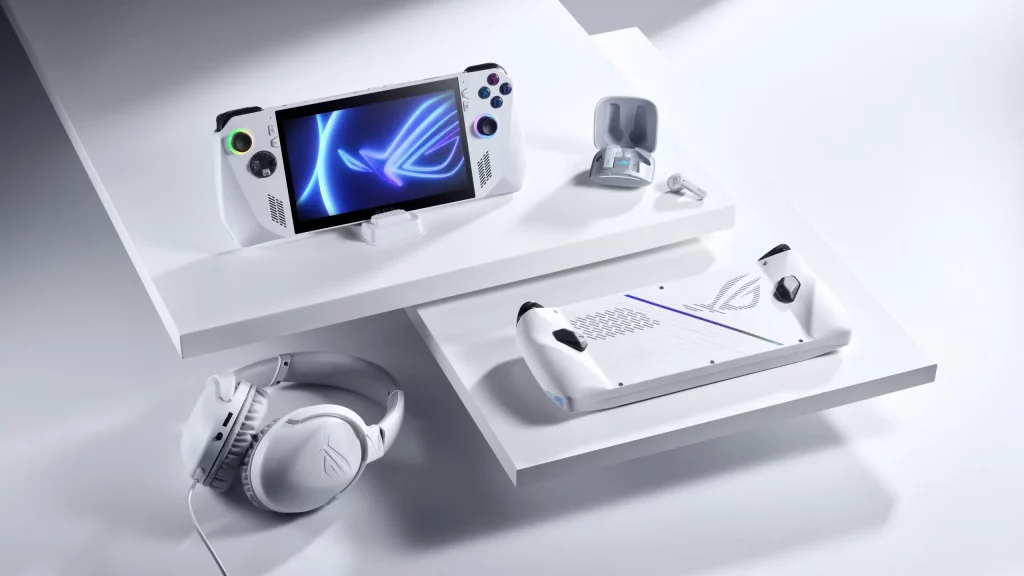Handheld gaming has become popular again since the introduction of the Nintendo Switch. ASUS’s ROG brand now comes with a Windows mini PC.
With the introduction of Valve’s Steam Deck, mobile gaming has received a huge boost in 2022. Reason enough for other gaming brands to also get into the new product category. Republic of Gamers, ASUS’ gaming brand, has made such an attempt with the ROG Ally.
ASUS immediately chose to take a different approach than Valve. For example, the ROG Ally doesn’t run Linux, it only runs Windows. This makes it possible to play almost all PC games, even if you can only get them from the Epic Games Store or another store. Windows Mobile is also welcome for competitive gamers: many games use anti-cheat software that doesn’t work on Linux. Thanks to ROG Ally, ASUS knows how to focus on a number of points that the Steam Deck does not pay attention to. So the ROG Ally and Steam Deck are two completely different devices. So the comparison is actually an apples to pears comparison. However, you’ll soon have to take a piece of the fruit home, which makes the comparison necessary. Or in this case: anyone who wants to play PC games from their lap can’t ignore the comparison.
hardware
When it comes to pure computing power, the ROG Ally clearly comes out on top. The AMD APU embedded in the Steam Deck LCD monitor provides 4 Zen 2 compute cores and 8 RDNA 2 GPU cores. In theory, this chip is good for 1.6 TFLOPs of computing power. Compare that with the Z1 Extreme, which is included in the more expensive version of the Ally. This device will have six Zen 4 computing cores and at least 12 RDNA 3 cores. The APU is good for a maximum of 8.6 TFLOPs of computing power. ASUS also wants to offer a better experience than Valve when it comes to the display: with the Ally you get a full 1080p display, while the LCD version of the Steam Deck is stuck at 1280 x 800 pixels. This corresponds to a resolution of 720p, but with a ratio of 16:10. ASUS is also doubling the refresh rate on the Steam Deck, offering 120Hz on the Ally. Plus, variable refresh rates (VRR) keep everything looking smooth at all times. In short: The ROG Ally’s 7-inch screen is much nicer than the Steam Deck’s LCD screen.
Control and comfort
When you hold the two devices side by side, you’ll immediately notice that ROG Ally is much thinner and lighter. This makes the device much easier to take with you. It’s immediately noticeable that there’s less resistance on the sticks, which makes the ally feel a bit cheap. The same goes for the paddles at the back, which look less sharp than competitors. Shoulder buttons are perfect for an ally. They have a nice click and are easy to access. The A, B, X and Y feel as they should and are very responsive.
Although the Ally is lighter and smaller than Valve’s Steam Deck, it does fit better in the hand. After playing for a while, the bottom corners of the laptop can start to press into your hands, which doesn’t feel very nice. After an hour or two we were always tempted to put the device aside and put it on the charger.
battery
The latter in particular has proven to be really essential on several occasions. The Steam Deck requires a maximum of 15W from the APU, while this limit increases to 30W for the ROG Ally. This allows you to discharge a 40 watt-hour battery in just over two hours. You can adjust how much power the Ally uses, but even then its battery life doesn’t come close to that of the Steam Deck. Even in simpler games, it’s noticeable that the Steam Deck lasts longer than its Windows counterpart. Maybe that’s where the culprit lies too: Ally also has to keep Windows running in the background. This requires more power than Valve’s Linux version, so you can’t go without a power socket for long. The charger provided by ASUS is more powerful, which means the device charges faster as well. To take advantage of this, there must of course be a power socket nearby.
Programming
One of the main differences between the two laptops is the operating system they run on. The ROG Ally simply runs Windows, and you can take that “normal” literally: even Excel has been ported over from the desktop version. It is quite clear that the interface has not been optimized at all for mobile devices. It seems that they at ASUS tried to find a way around this with the Armory Crate. That was only half the success. Although the Command Center, which you can summon as a sidebar with the touch of a button, is useful, the software leaves a lot to be desired. For example, it can’t always find all the games, the interface can be very confusing and the whole thing looks not only very boring, but a bit ugly as well. The Big Picture mode of rival Steam has increasingly proven to be a more enjoyable way to use the device.
So software is the ROG Ally’s biggest pain point. It has happened many times that we briefly connected to a WiFi network while on the road, just to have the Windows, BIOS or firmware update down our throat. Furthermore, you can’t click away from the prompt that suggests you perform firmware updates. Installing the update also only works if the device is connected to the mains power source. In other words: bad luck, but the games are for tomorrow.
performance
The Ally has a powerful APU with which it can achieve a lot, but all that potential is immediately consumed by the higher resolution at which games are run. On top of that, an overworked Windows system also has to keep running, which means you’ll lose some computing power up front. This is noticeable, no matter what game you are playing. If you compare both devices at their standard resolution, you will see that the Steam Deck delivers higher fps. Furthermore, on both devices, all tests were performed using FSR 2.1 at the Quality setting, as ASUS recommends.

Which device should you choose? This depends on what type of player you are. Do you prefer sharp, beautiful images or do you prefer fast framerate results? It’s undeniable that images look much better on the ROG Ally Display than on the Steam Deck LCD. ASUS has also added a mode for playing games at 900p, but that’s a waste of money: you’re paying a premium for that better screen. They are actually apples and pears and they are both delicious for different reasons. Additionally, keep in mind that both Valve and ASUS are constantly pushing updates to devices that can improve or degrade performance.
Conclusion
The ROG Ally and Valves Steam Deck are two equally well-matched devices. Gamers interested in mobile devices just have to ask themselves a few questions. How many competitive games with anti-cheat software do you want to play? Do you value visual fidelity or speed more? You’ll basically have to answer these questions yourself. In any case, don’t let yourself be trapped by Windows: if there’s one thing that detracts from the ROG Ally experience, it’s this operating system with its many updates. What’s more, this white ASUS laptop makes it easy to take your games everywhere – if the device doesn’t need an update, that is. Moreover, with Ally, you can also install your Game Pass games locally, without relying on the cloud. However, you need an internet connection to run it.
Please note: ASUS releases two versions of Ally. The current version with the Z1 Extreme chip is the most expensive and fastest version. There is also a version with a regular Z1 processor. It is not yet known how it will perform, but the device certainly will not improve.

“Lifelong entrepreneur. Total writer. Internet ninja. Analyst. Friendly music enthusiast.”











More Stories
Oudsbergen: New windows and doors (May 16, 2024)
Final call: Will you be coming to the Data News Awards on May 30?
Google launches the second beta version of Android 15 with the feature of hiding applications – tablets and phones – News